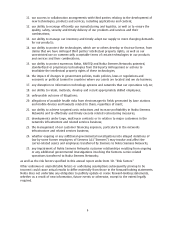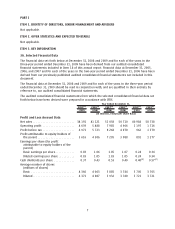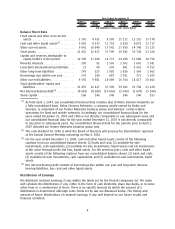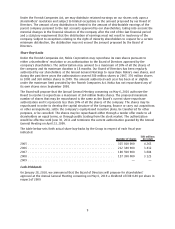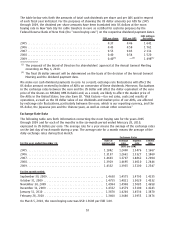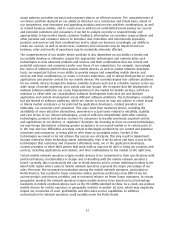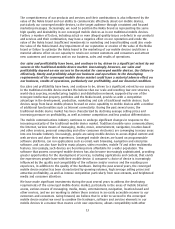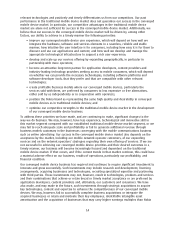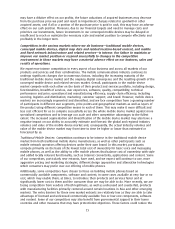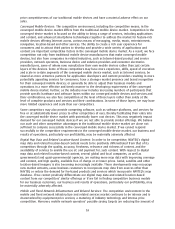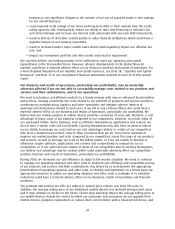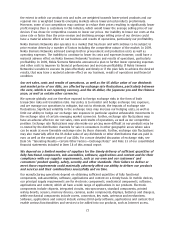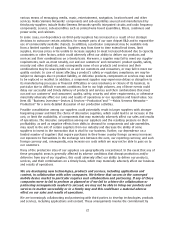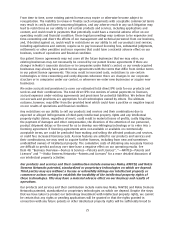Nokia 2009 Annual Report Download - page 18
Download and view the complete annual report
Please find page 18 of the 2009 Nokia annual report below. You can navigate through the pages in the report by either clicking on the pages listed below, or by using the keyword search tool below to find specific information within the annual report.price competitiveness of our traditional mobile devices and have a material adverse effect on our
sales.
Converged Mobile Devices:
The competitive environment, including the competitive means, in the
converged mobile device market differs from the traditional mobile device market. Competition in the
converged device market is focused on the ability to bring a range of services, including applications
and content, and advanced smartphone technologies together to address the market for featurerich
mobile devices offering Internet access, various means of messaging, media, music, entertainment,
navigation, locationbased and other services. The ability to create a rich user experience for
consumers and to attract third parties to develop and provide a wide variety of applications and
content are important competitive factors in the converged mobile device market. As a result, we face
competition not only from traditional mobile device manufacturers that make converged mobile
devices, but also from companies in related industries, such as Internetbased product and service
providers, network operators, business device and solution providers and consumer electronics
manufacturers, some of whom now manufacture their own mobile devices rather than just certain
layers of the devices. Some of those competitors may have more experience, skills, speed of execution
and scale in certain segments of the converged mobile device market, such as Internet services; be
viewed as more attractive partners for application developers and content providers resulting in more
potentially appealing services for consumers; have a stronger market presence and brand recognition
for their converged mobile devices; or generally be able to adjust their business models and
operations in a more effective and timely manner to the developing requirements of the converged
mobile device market. Further, as the industry now includes increasing numbers of participants that
provide specific hardware and software layers within our converged mobile devices and services and
their combinations, we also face competition at the level of those layers rather than solely at the
level of complete products and services and their combinations. In some of those layers, we may have
more limited experience and scale than our competitors.
Some competitors may also provide competing software, such as software platforms, and services for
free or at substantially lower prices to other competitors of ours, thereby facilitating their entry into
the converged mobile device market with potentially lower cost devices. This may negatively impact
demand for our converged mobile devices if we are not able to provide similar offerings. We believe
our scale and other competitive advantages in the traditional mobile device market are alone not
sufficient to compete successfully in the converged mobile device market. If we cannot respond
successfully to the competitive requirements in the converged mobile device market, our business and
results of operations, particularly our profitability, may be materially adversely affected.
Digital Map Data and Related Locationbased Content:
In order to be competitive, NAVTEQ’s digital
map data and related locationbased content needs to be positively differentiated from that of its
competitors through the quality, accuracy, freshness, relevance and richness of content, and the
availability of services to enable the use of, and payment for, such content. With respect to digital
map data and related locationbased content, several global and local companies, as well as
governmental and quasigovernmental agencies, are making more map data with improving coverage
and content, and high quality, available free of charge or at lower prices. Aerial, satellite and other
locationbased imagery is also becoming increasingly available. Those developments may encourage
new market entrants, cause business customers to incorporate map data from sources other than
NAVTEQ or reduce the demand for feebased products and services which incorporate NAVTEQ’s map
database. If we cannot positively differentiate our digital map data and related locationbased
content from our competitors’ similar offerings or if we fail in finding competitive business models
for our business customers, our business and results of operations, particularly our profitability, may
be materially adversely affected.
Mobile and Fixed Network Infrastructure and Related Services:
The competitive environment in the
mobile and fixed network infrastructure and related services market continues to be intense and is
characterized by equipment price erosion, a maturing of industry technology and intense price
competition. Moreover, mobile network operators’ possible saving targets are reducing the amount of
16


